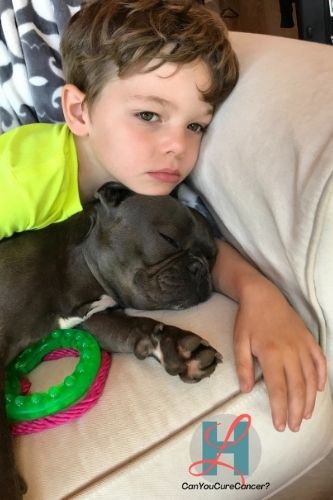




Moral Support & What It Looks Like
This blog on emotional support animals and moral support is not intended to treat, diagnose or advise. See my full disclaimer if you want to read further.
Let’s face it, if you’re grieving, dealing with a cancer diagnosis- or any other of life’s stressors, you’re likely needing some support! Support looks different to everyone. Having recently lost my husband, following his battle with cancer, I can tell you that I have a few definite likes and dislikes on the topic.
Dislikes
- Words of encouragement…. Yes really! Keep reading, more to come.
- Devil’s advocate. I’m not needing, or looking for, the bright side at the moment.
- Untruths. Compliments fall pretty flat currently, as I know I’m not my best self.
- Forced company. Check out my blog on Stages of Grief. Sometimes alone is ok.
- Being with those who hold strong around me. My heart won’t feel safe to be authentic.
Likes
- Listening more than talking. Silent Support.
- Emotional support animal (s). They’re the best listeners.
- Alone time. Not always the case, but occasionally needed.
- Those who cry with me. Still very much supportive. Takes more courage than pretend positivity.
- Those who agree It. Just. Sucks.
Emotional Support Animal(s)


Emotional support animals are the best at never saying the wrong thing! Am I right? A silent cuddle. A warm snuggle during a cold time. Gratitude and appreciation with no strings attached. Supportive without judgment. This type of moral support can be its own beautiful little support system all wrapped into one adorable package.
Since emotional support animals rank at the top of my personal list of moral support during anything stressful, I want to dig a little deeper on this specific support system.
So let’s consider some pros & cons.
Cons
- They still need you. You have to continue to meet their needs. You have to feed them, let them out and/or exercise (depending on the animal you choose)!
- Potential costs if you suddenly find your financial security in jeopardy.
- Training. A true emotional support animal may need to be trained. If you’re just getting a pet to up your mood, this is also incredible emotional support, but a new dog for instance, takes training and that takes time you may, or may not, have. You don’t need the stress of a chewed sofa, or puddle in your kitchen.
- ……Yup that’s all l’ve got!

Pros
- They still need you. You have to continue to meet their needs. You have to feed them, let them out and/or exercise (depending on the animal you choose)! I find this to be a pro and a con. Something that forces you to care for someone other than yourself and get up and going can be a blessing. I know this from personal experience.
- Studies have shown that animals can positively affect our Oxytocin levels in our body. 1 I’ll get into more of that below, but this is a HUGE advantage.
- Lower blood pressure and smaller increases during stressors and recovers faster. 2,3,4
- Lower heart rate and smaller increases during stressors and recovers faster. 2,3,4
- Skin conductance 2 This was a study that looked at how women’s stress responded in various conditions including a female friend, pet dog, or absence of either. They used autonomic responses (think things that happen automatically in your body) to stress to see what worked best. Pet conditions, once again, showing less reactivity to stress!
- Plasma renin activity. Plasma what?! Exactly! Let me explain in actual English what this means. Renin is a plasma enzyme that plays a big role in how your body regulates blood pressure, urine output, thirst (really important health factors). This study was SO exciting! They concluded that while ACE Inhibitor Therapy (lisinopril) lowered resting blood pressure, pet ownership significantly lowered blood pressure, heart rate and plasma renin activity response to mental stress! 4
- Decreased loneliness 5
- Stress reduction (goes back to improving Oxytocin) Study looked at stress reduction with presence of friends, spouses and pets during stress and pet owners, when their pets were present had the best result in stress reduction!
- Reduction of stress & cortisol. 6
- Reduction of fear & anxiety 7 Aquariums have shown great progress in this space, plus a fish is a lower maintenance emotional support animal. 8
- Decrease in depression 9
- Improved empathy with first grade students, as well as, less aggression, more social integration and improved independence. 10
If you can believe it, there are so many additional, researched pros, that I had to stop here. Clearly the pros outweigh the cons here!
What This All Means For Creating A Supportive Environment
Since a supportive environment requires a person to feel supported, no two people will likely have a matching picture of what this looks like.
My husband, as you can see in the above pictures, adored our dogs. He never admitted just how much they offered him in the way of comfort, but it’s clear to see.
When his cancer fight was not progressing as we wanted it to, a barking dog when my kids started sprinting up our stairs, was not exactly a relaxing and stress free environment.
My kids kept trying to put our dog up on my husband, when he was stuck in his hospital bed, expecting that because it reduced their stress so much and they knew how much he loved our dog, that it would help. Sadly, it didn’t.
Hospice can be very stressful to someone who is not mentally prepared to pass. My husband was worried about tubes that may get pulled out and the dog scratching his fragile skin. The medications he was on are likely the cause of his elevated anxiety, but ultimately, the dog ended up being an emotional support for the kids and I mostly.
This is certainly just our own experience.
The moral of this moral support strategy is that you need to make a list and figure out what brings you calm and happy. What can you afford financially and afford the time to take care of.
Summary Of Important Points To Consider
The end goal should always be increasing oxytocin levels (think happy hormone) and reducing cortisol (stress hormone) in our body, when speaking of stress reduction. Let’s face it, you wouldn’t be looking at emotional support animals if you weren’t searching for lessening your stress. The evidence exists in spades, that an emotional support animal provides lowered stress with cortisol reduction and improved oxytocin.
What is it about oxytocin that’s so important and why is cortisol so evil? Think of them as anti-stress and stress hormones. Guess what feeds cancer? Stress and cortisol. Guess what is therefore great for fighting cancer? Anything that combats those things. Cortisol has its role, but it needs to learn when to take a seat and be silent.
Not all of us view things the same and what lowers one’s stress, may elevate someone else’s. In terms of when someone is looking for a supportive environment, limiting things from the ‘dislike’ list above is a good place to start, although be sure my list matches theirs.
I’m sure you’re still wondering why words of encouragement made its way to that list? It may sound odd, but in my experience with widows (and my job has given me the opportunity to speak with many), they just want a silent support system.
Listening, agreeing and just letting your loved one pour out their heart without words of support back may feel completely out of your comfort zone, but cancer and grief…. whew! It’s deep! Offering supportive, comfort words feels good to you, but not necessarily to the person you’re trying to support.
They may not want to hear that it’s going to be okay, or that time will help. It’s hopeful, but it may bring up frustration to the person you’re trying to be there for. No one has the answers. They’ve likely searched desperately for answers and fell short. Just being there and letting them know that you are there, for whatever they need, is everything.
Animals offer unconditional support, without doing anything at all, except being there. We can all learn a lot from our furry, little companions (or not so furry, no discrimination here!)
Happy deciding!

References
1 Beetz A, Uvnäs-Moberg K, Julius H, Kotrschal K. Psychosocial and psychophysiological effects of human-animal interactions: the possible role of oxytocin. Front Psychol. 2012;3:234. Published 2012 Jul 9. doi:10.3389/fpsyg.2012.00234Beetz A, Uvnäs-Moberg K, Julius H, Kotrschal K. Psychosocial and psychophysiological effects of human-animal interactions: the possible role of oxytocin. Front Psychol. 2012;3:234. Published 2012 Jul 9. doi:10.3389/fpsyg.2012.00234
2 Allen KM, Blascovich J, Tomaka J, Kelsey RM. Presence of human friends and pet dogs as moderators of autonomic responses to stress in women. J Pers Soc Psychol. 1991;61(4):582-589. doi:10.1037//0022-3514.61.4.582
3 Allen K, Blascovich J, Mendes WB. Cardiovascular reactivity and the presence of pets, friends, and spouses: the truth about cats and dogs. Psychosom Med. 2002;64(5):727-739. doi:10.1097/01.psy.0000024236.11538.41
4 Allen K, Shykoff BE, Izzo JL Jr. Pet ownership, but not ace inhibitor therapy, blunts home blood pressure responses to mental stress. Hypertension. 2001;38(4):815-820.
5 Banks MR, Banks WA. The effects of animal-assisted therapy on loneliness in an elderly population in long-term care facilities. J Gerontol A Biol Sci Med Sci. 2002;57(7):M428-M432. doi:10.1093/gerona/57.7.m428
6 Barker SB, Knisely JS, McCain NL, Best AM. Measuring stress and immune response in healthcare professionals following interaction with a therapy dog: a pilot study. Psychol Rep. 2005;96(3 Pt 1):713-729. doi:10.2466/pr0.96.3.713-729
7 Barker SB, Pandurangi AK, Best AM. Effects of animal-assisted therapy on patients’ anxiety, fear, and depression before ECT. J ECT. 2003;19(1):38-44. doi:10.1097/00124509-200303000-00008
8 Barker S. B., Rasmussen K. G., Best A. M. (2003b). Effect of aquariums on electroconvulsive therapy patients. Anthrozoos 16, 229–24010.2752/089279303786992071
9 Crowley-Robinson P., Fenwick D. C., Blackshaw J. K. (1996). A long-term study of elderly people in nursing homes with visiting and resident dogs. Appl. Anim. Behav. Sci. 47, 137–14810.1016/0168-1591(95)01017-3
10 Hergovich A., Monshi B., Semmler G., Zieglmayer V. (2002). The effects of the presence of a dog in the classroom. Anthrozoos 15, 37–5010.2752/089279302786992775

